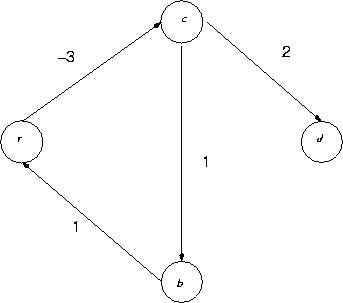Stanford
University
MS&E 217,
Combinatorial Optimization
Autumn
2003-04
Home | Handouts | General Information
|
Announcements |
|
|
|||||||||||||||||||||
|
Class Information |
|
|
|||||||||||||||||||||
|
Syllabus, Evaluation, homeworks |
|
Please
see the general
information page. |
|||||||||||||||||||||
|
Discussion sessions schedule |
|
|
Optional Excercises
|
|
1.1 |
|
Consider
the following algorithm:
Answer:
No. The definition in class said that an algorithm is efficient if its
running time is polynomial in the input size. In this case, the input is n.
But to write down the integer n, we need roughly log n bits. So the “size” of
the input is only X = log n. The
running time of the algorithm is sqrt(n), which is polynomial in n, but NOT
in the input size X; it isO( 2X/2) which is exponential in the
input size. |
||
|
|
2.1 |
|
Show
that there exists an infinite series of relaxations for the following graph: Answer:
The pattern of relaxations ab,bc,ca can be repeated infinitely often. |
||
|
|
3.1 |
|
Find
a simple modification to the Bellman-Ford algorithm (as discussed in class)
that enables it to determine if a negative cost cycle exists. Answer:
Run the algorithm for n iterations as opposed to n-1; if any potential
changes in the n-th iteration, then there exists a negative cycle. |
||
|
|
5.1 |
|
Show
that for the fractional knap-sack problem, it is sufficient to examine
finitely many possible allocations. Answer:
At most one item is picked fractionally, and can be picked in n different ways.
We can pick up any subset of the remaining n-1 items, which makes a total of
at most n2n-1 possible choices. |
||
|
|
6.1 |
|
What
impact do –ve weight edges have in the minimum spanning tree problem? Is
there a simple pre-processing step that gets rid of –ve weight edges? Answer:
Minimum weight edges have no impact on the mst problem. Also, we can add a
large positive value to each edge-weight to make sure all edge weights are
non-negative. |
||
|
|
16.1 |
|
Prove
that in the case when we are given both lower bounds le and upper
bounds ue on the flow xe through an edge, we can assume
le ≠ -∞. Hint:
Read page 98 on the text and exercise 4.1. |
||
|
|
17.1 |
|
Show
that there exists a set of preferences such that the stable mrriage algorithm
of Gale and Shapley requires Omega(n2) days to complete. |
||
|
|
18.1 |
|
Suppose
G is a bipartite graph and M is a matching in G. Use max-flow/min-cut
techniques to prove that there is no M-augmenting path iff M is a maximum matching.
|
- (12/1) Extended office hours (2-4) on M Dec 1, W Dec 3, and from
1:00-3:0 pm on M Dec 8.
- (12/1) Discussion section on Dec 5th - will discuss problems
from the set below. If you have any preferences from within these (or from
outside), let me know by Thu morning.
- (12/1) Handout
13 is now online: Practice problems for the final.
- (11/30) Online poll results: In class final.
- (11/14) Online
poll: Do you want a take home or an in-class final? Send me email.
- (11/14) Homework
3 is now online.
- (11/14) Readings posted for a
combinatorial optimization problem in game theory (317 only), and for
stable marriages (see handouts).
- (11/10) Discussion section (optional) this Friday for MS&E
317 students on a combinatorial optimization problem in game theory.
- (10/24) Practice
problems for the midterm are now online.
- (10/24) Addendum
to HW 2 on matroids is now online. Due 10/31/03. For MS&E 317
students only (and optional even for MS&E 317).
- (10/22) HW 2
is now online. Due 10/31/2003.
- (10/17) Discussion section schedule
updated. Oct 24th: Discussion section on Matroids for MS&E
317 students. Oct 31st: Problem solving session. Will hand out
three dynamic programming problems and a few other problems well in
advance. Please treat these as practice problems for the midterm. We will
discuss any doubts you have about these problems and about anything else
on Oct 31st.
- (10/8) HW 1
is now online. Due 10/17/03, in class.
- (10/08) The Friday, Oct
10 discussion section shall be on data structures (heaps).
- (10/05)
We will not have a TA for this class any longer. Contact the instructor
for any academic/administrative issues.
- (10/01) The Friday, Oct
3 discussion section shall be on linear programming and not
data structures as previously announced.
- There will be no class on the 13th
of October. There will be a make up class on Oct 17th instead.
- Handout 1 is online; please
turn it in by the second class.
- (09/25) There will be no TA office hours this week.
